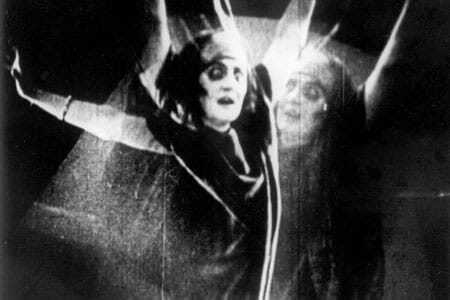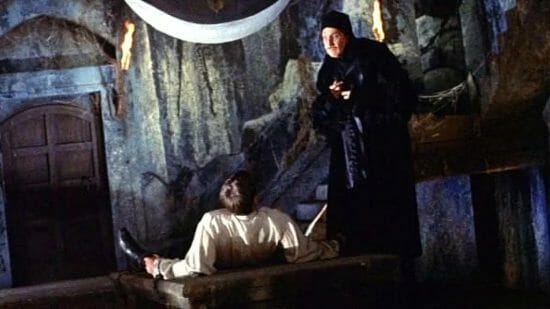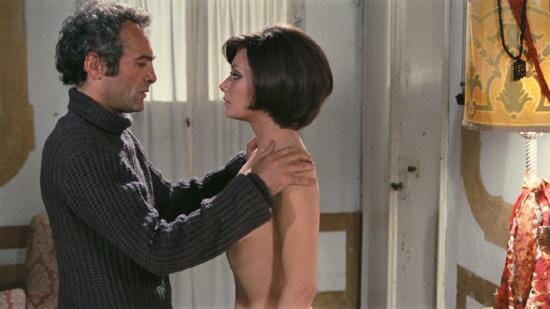The 13 Best Edgar Allan Poe Movies

Stephen King may reign supreme as the horror author most adapted to film, but that title once belonged to another American master of the macabre: Edgar Allan Poe. Poe died a few decades before the first proto-movies started showing off horses galloping or men sneezing, but his popularity was already established in the U.S. and Europe—and his influence on popular genres like detective and horror fiction was already a noted selling point to the soon-to-be-moviegoing masses.
That meant Poe stories were hot commodities from the jump, making their way to the cinema starting in the 1910s (with one of the first German art films, 1913’s The Student of Prague, which helped inspire the Expressionist cinema of The Cabinet of Dr. Caligari a few years later) and running through the 1930s, which saw multiple Bela Lugosi/Boris Karloff Poe team-ups. His name, and his stories, were constant exploitation draws, eventually attracting royalty of the form in the ‘60s: Roger Corman and Vincent Price. With their fascinating, beloved eight-film run of Poe adaptations (even if The Haunted Palace was actually an H.P. Lovecraft story that just nabbed a random Poe title), the pair helped bring humor, color and fun to their B-grade Poe that would help him maintain his reputation among modern horror aficionados.
Unlike Lovecraft, whose penchant for profound, indescribable tentacle monsters and cosmic horror went through a recent popular revival (not unrelated to his work’s exciting opportunities for effects and makeup artists), Poe’s Gothic style has a more mass appeal. His madness is of a far more human sort than Lovecraft’s; his deathly horrors far more mundane and inevitable. That means straight adaptations, while relatable, can come off a bit dull and stagey—Poe works flourish when filmmakers use the medium to tap into his characters’ troubled psyches. As modern directors continue the grand tradition of adapting Poe, even as the adaptations continue the equally grand tradition of being fast and loose, the diverse world of Poe horror films still delivers.
Here are the 13 best Edgar Allan Poe adaptations:
The Black Cat (1934)Director: Edgar G. Ulmer

The complete filmography of movies that claim to be adapted from the works of Edgar Allan Poe range from experimental, short art films, to slavish feature-length adaptations, to quite a few in the mold of The Black Cat: Horror-thrillers that swipe the names of famous Poe stories for their visibility in marketing otherwise unrelated films. You’ll see it throughout the 1930s and 1940s, and again under the watchful eye of Roger Corman in the 1960s—the Poe name must be one of the most exploited in horror history, although H.P. Lovecraft would likely give him a run for his money these days. The Black Cat, however, really doesn’t need the Poe embellishment to stand out—all it needs is the names of its two stars, meeting here in their first of eight pairings. Bela Lugosi and Boris Karloff were the two preeminent horror genre stars of their day, for obvious reasons. In portraying the two most important Universal monsters, each actor ensured both fame and typecasting that would last throughout their careers, but in 1934 it’s still early enough that neither seems to resent having to appear primarily in horror fare. Here, these two icons just seem to be having a great time, portraying two equally mad (although not quite equally heinous) doctors with vendettas against one another. Our protagonists are technically the newlywed couple who get swept up in the diabolical game of cat and mouse playing out between Lugosi’s Dr. Werdegast and Karloff’s Dr. Poelzig, but Universal knew damn well the audience had no particular interest in the story’s ingénues. They were here to see Karloff vs. Lugosi, and in that respect The Black Cat does not disappoint. Make no mistake, this is very much a pre-Code horror film, with plenty of content that would not have flown if it had been completed just a few months later. From the implied rape of Karloff’s stepdaughter to the film’s sacrilegious Satanism angle and hints at deeper perversions on the part of Poelzig, The Black Cat is about as depraved as horror films of the era get. Both leads ham it up, determined to destroy one another. Lugosi is playing the lesser of two evils this time around, a wild man who wants revenge on Karloff after spending 15 years behind bars. He’s completely unhinged, his mind having been left behind with the body of his dead wife. Karloff, on the other hand, is playing the sinister mastermind archetype he does so well, grinning with arrogant self-satisfaction and letting others do his dirty work for him. It all builds to a conclusion where even the implied violence is surprisingly grotesque. Unfortunately, The Black Cat represents a high point of the Lugosi-Karloff team-up pictures, which would slowly ebb in quality, with one very notable exception: Son of Frankenstein.—Jim Vorel
The Bloodhound (2020)Director: Patrick Picard

A simmering and strange modern take on “The Fall of the House of Usher,” The Bloodhound stands tall thanks to writer/director Patrick Picard’s modernist vision and a fascinatingly off-kilter lead performance from Joe Adler. Adler plays JP, a reclusive little fancy lad who reconnects with an old friend (Liam Aiken) as they both suffer through mental crises. This is, however, after we see a faceless, crawling being squirm into JP’s ritzy house and hide itself away in a wardrobe. That kind of back-of-your-mind dread haunts the entire film, a weight that imbues the intentionally stagey dialogue with a kind of farcical horror—why won’t they recognize all the terrible things going on under this obvious superficiality? Shot like a dream—sometimes hazy and dark, sometimes using an odd fixed angle like a Resident Evil game—the slick and upsetting adaptation proves that Poe and his fears live on.—Jacob Oller
An Evening of Edgar Allan Poe (1970)Director: Kenneth Johnson

If you’re ever hosting a Halloween party, by all means queue up An Evening of Edgar Allan Poe, which simply features Vincent Price in a chair, narrating a bevy of Poe stories with his camp-o-meter turned up to 11. It sets the mood pretty beautifully.—Jim Vorel
Extraordinary Tales (2013)Director: Raul Garcia

There is so much bargain bin, straight-to-VOD horror trash streaming out there that it’s all too easy for something like Extraordinary Tales to go completely unnoticed, and that’s a shame. This anthology of animated, narrated stories from Edgar Allan Poe may be uneven in terms of quality, but dammit if it’s not far more artistically interesting than another found footage horror turd that was shot in the course of a weekend in Bulgaria. Extraordinary Tales is remarkable for the level of talent the filmmakers were able to bring on as narrators or voice actors: Christopher Lee, Guillermo del Toro, Julian Sands and Roger Corman, reprising his own interest in Poe that led him to direct films such as House of Usher and The Raven in the ‘60s. There’s even a unique rendition of The Tell-Tale Heart that is narrated via archival recordings by Dracula himself, Bela Lugosi! Each story is likewise presented in a different style of animation, which sadly is of varying quality. But for the sheer novelty of hearing Christopher Lee perform “The Fall of the House of Usher,” or the attractive animation of “The Facts in the Case of M. Valdemar,” Extraordinary Tales is worthy of attention.—Jim Vorel
The Fall of the House of Usher (1928)Director: Jean Epstein

Jean Epstein’s The Fall of the House of Usher has such an otherworldly feel, it seems you could get lost in the ether just watching it. Multiple exposures were much more common in the silent era, as directors attempted new ways to visually communicate ideas, but Epstein takes it to another level, with layers of visual fog that add dread to each shot. Whether we’re simply watching a dog running away or witnessing a house fall to ruin, Epstein evokes Edgar Allan Poe’s morbid fright whether or not he’s paying much mind to the details of the source material.
-

-

-

-

-

-

-

-

-

-

-

-

-

-

-

-

-

-

-

-

-

-

-

-

-

-

-

-

-

-

-

-

-

-

-

-

-

-

-

-
















































